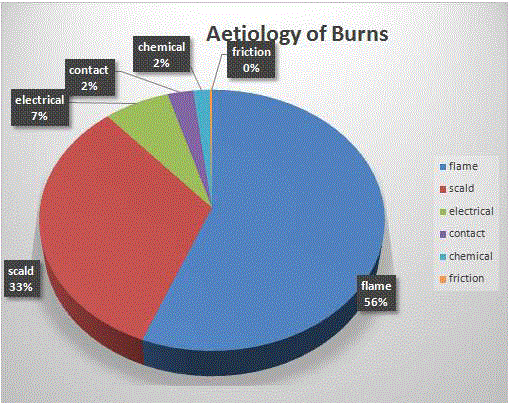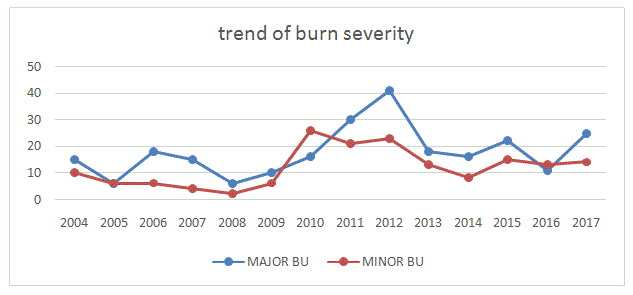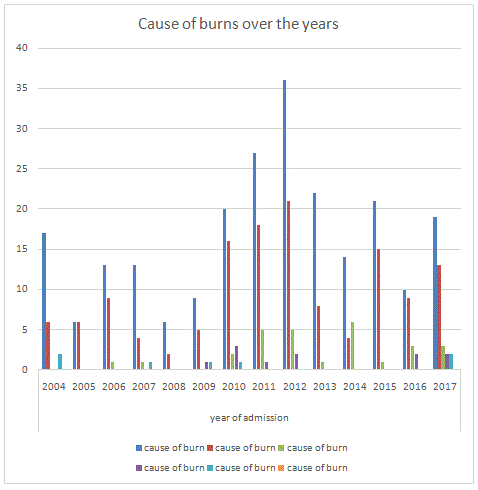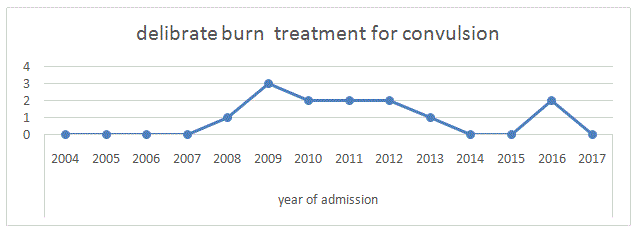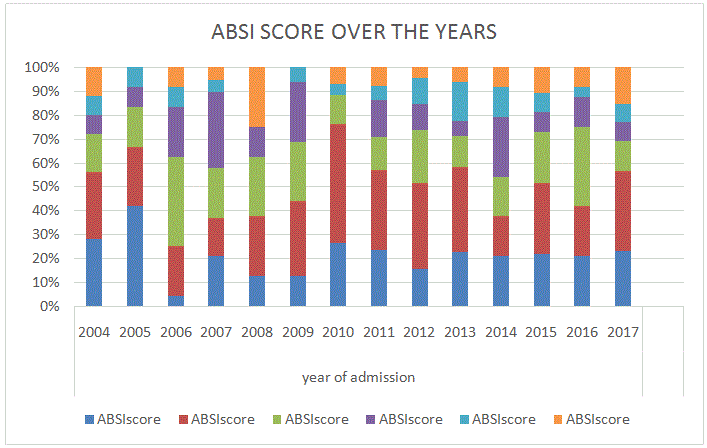Research Article
Burn Injury Patterns and Validation of the Abbreviated Burn Severity Index as a Predictor of Outcome in a Southwestern Nigerian Hospital
Ayodeji Olanrewaju Oladele1*, Anthony Alome Olekwu2, Olakunle Fatai Babalola3, Muhammad Habib Ibrahim4 and Rereloluwa Nicodemus Babalola5
1Department of Surgery, Obafemi Awolowo University, Nigeria
2Department of Surgery, Federal Medical Centre Owo, Ondo State, Nigeria
3Department of Surgery, Federal Teaching Hospital, Ido-Ekiti, Ekiti State, Nigeria
4Department of Surgery, Federal Medical Centre BirninKebbi, Kebbi State, Nigeria
5Department of Surgery, Obafemi Awolowo University Teaching Hospital, Nigeria
*Corresponding author: Ayodeji Olanrewaju Oladele, Department of Surgery, Obafemi Awolowo University, Ile-Ife, Nigeria
Published: 30 Oct, 2018
Cite this article as: Oladele AO, Olekwu AA, Babalola
OF, Ibrahim MH, Babalola RN. Burn
Injury Patterns and Validation of the
Abbreviated Burn Severity Index as a
Predictor of Outcome in a Southwestern
Nigerian Hospital. World J Surg
Surgical Res. 2018; 1: 1070.
Abstract
The pattern of burn injuries are dynamic and vary between places being influenced by several
factors. This informs the need for periodic review of patterns of burn injuries. Predicting burned
patients outcome is important to clinical decision making, prognostication as well as optimal
hospital resource allocation. Several models of achieving this have been developed, each with
varying strengths and shortcomings. This study aims at describing the current pattern of acute burn
injury as well as validates the Abbreviated Burn Severity Index (ABSI) as an outcome predictor in
burn patients in the study setting.
This is an observational study from the database of patients with burn injuries managed at the study
institution over a 14 year period. The information analyzed was obtained from the clinical database
of burn patients, imputed into computer software SPSS software for analysis.
The total number of burn patients seen during the period was 416. Children and teenagers (0 to 20
years) were most commonly affected making up 47.8%. The mean age of patients was 23.4 years
(SD=20.1 years). Burn injuries commonly resulted from flame (56%), scald (33%) and electricity
(6%). A male, female ratio of 1.7:1. Inhalational injury was present in 15.6% of patients. Overall
mortality was 25.2%. ABSI score was effective in the prediction of mortalities.
There is an increase in the frequency of electrical burn injuries, as well as severity of burn injuries
at the center and ABSI score is an effective predictor of mortality amongst patients with acute burn
injury.
Keywords: Abbreviated burn severity index; Burn injury; Prognostic burn index
Introduction
Burn injury remains a major source of trauma worldwide. The patterns are dynamic [1] and vary
with places and socioeconomic levels among other factors. This informs the need to periodically
review trends in burn injuries to keep up with effective prevention and management strategies.
Although burn survival has improved over the years due to advances in burn care such as early
burn wound excision, the use of silver impregnated dressings, improvement in critical care as well
as the use of skin banks and skin substitutes among others [2], the prediction of outcome in acute
burn patients is still of interest to the burn surgeon [3]. This is important as it aids triage, guides
clinical decision making on prognosis and resource allocation, particularly in resource-limited
settings [4,5].
This study therefore aimed at reporting the current trends in the clinical pattern of burn injury
in our practice as well as validate the effectiveness of the Abbreviated Burn Severity Index (ABSI)
score, as a predictor of outcome.
Figure 1
Figure 2
Figure 3
Methods and Materials
This observational study of burn patients admitted for care at the Obafemi Awolowo University Teaching Hospital (OAUTHC), Ile Ife, Nigeria, over a 14 year period (January 2004 and December 2017). The information obtained from patients clinical database was utilized for analysis. The Patients’ fluid resuscitation was based on Parkland formula and was monitored by hourly urine output along with the vital signs and oxygen saturation. Burns above 15% total body surface area was considered major. Patients with inhalation injury were assessed clinically. The ABSI score was calculated for each patient using the parameters in table 4, and stratified into six groups; 2 to 3, 4 to 5, 6 to 7, 8 to 9, 10 to 11, ≥ 12. The outcome measures were death and discharge from the hospital. Those who were referred or transferred to other hospitals or who discharged against medical advice were noted. Statistical analysis was with SPSS software.
Figure 4
Figure 5
Table 1
Results
A total of 416 burn patients were managed during the period.
Their age and gender distribution is shown in Table 1. The mean
age of patients was 24.2 years with a range of 3 months to 90 years.
Children below 15 years of age made up 38.2% and male gender
constituted 62.7%. The peak age of patients was the 0 to 20 years agegroup
(47.8%). The etiology of burn injuries is shown in Figure 1. All
causes of burn were more common in males except chemical burns
which were more common in females but the numbers were few.
The average extent of burn was 27.5% (28.2% for males and 26.4%
for females), 249 patients (59.9%) had burns greater than 15%. The
details of total body surface area burned and the frequency is shown
in Table 2. The pattern of severe burns above and below 15% TBSA
over the period is as shown in Figure 2.
The burn injuries were accidental in 400 patients (96.2%) and
deliberate in 16 (3.8%), the latter being made of 13 (3.1%) patients
who had feet burns following attempts to resuscitate a convulsive episode and 3 (0.7%) patients who were assaulted, 2 cases from scald
and 1 was chemical burn. The trends for all causes of burns is shown
in Figure 3, while that for patients who had deliberate burns following
convulsive episodes over the years in shown in Figure 4. Inhalational
injury was present in 15.6%.
The overall mortality was 25.2%, (25.7% in males and 24.5% in
females) while mortality from flame burns was 59.6%, electrical burns
16.7%, scald 11.5%. There were no mortalities from chemical and
contact burns. The average TBSA among survivors was 16.1%, while
among the dead was 55.8%.
The patients who were discharged home were 66.6% of the total,
and others were transferred to other facilities for further care. The
outcome of acute burns and the prediction of survival using the ABSI
score is shown in Table 3. The mean ABSI among survivors was 4.7
while that for mortality was 9.8. The pattern of severity using the
ABSI score is shown in Figure 5.
Table 2
Discussion
The pattern of burn injuries have changed in some respects and
unchanged in others, over the last 14 years compared to previous
reports [6,7].
The ratio of males to females has remained unchanged at 1.7:1
to 1.8:1, flame burns remains the highest cause but is slightly lower
than in the past. The average total body surface area burned has
increased from 25.4 in 1997 and 25% in 2004 to 27.2%. The frequency
of electrical burn injuries has increased from 0.7% to 1.5% of total
to 6% of patients with burns. The mean age of burn injuries is also
higher from 19.5 years and median age of 18.5 years to 24.2 years.
Scald injures which constituted 40.5% of cases have reduced to 33%.
The overall mortality which was 21.8% in 1997 but increased to 30.9%
in 2004 is now 25.2% and could be considered an improvement. A
survival rate of 66.6% is less than the 69% previously reported as 8.1%
were either referred to other facilities for further care or discharged
themselves from our care and their eventual outcome could not be
ascertained.
Chemical burns have remained few and far between but the
practice of deliberate burn for patients with febrile convulsion
appears to be on the decline as shown in Figure 4. This practice which
was observed to be common in many parts of the country may be on
the decline due to improving public health awareness [8].
The severity of burn injuries at the center also appears to be on the
increase along with an upsurge observed around the year 2011. These
are probably due to increased incidence of burns observed during
periods of premium motor spirit scarcity, with attendant poor safety
precautions at such times. The more severe burns are also presented
to the center which is a tertiary health facility while burns of less
severity may be managed at other primary and secondary health
facilities. This may account for the higher mortality seen in the study.
The prediction of mortality from burns continues to be of interest
and the validation of the ABSI is presented in this study. The ideal
formula for the prediction of mortality from burns should be simple;
based on a minimal set of easily obtainable variables [9]. Various
scores have been in use over the years [10]. The Burn Index, which
is the sum of the total full thickness TBSA and half of the partial
thickness TBSA is well known [2].
The Baux score which is the patient’s age in years plus the
percentage of the Body-Surface Area (BSA) burned is easy to
remember and is useful for early outcomes assessment but said to
have various limitations regarding long-term survival or mortality
prediction [11,12]. It is widely accepted and was regarded as a
landmark scoring system in the field of burn research in the United
States of America [13].
The Prognostic Burn Index (PBI), is as a combination of the burn
index and the age of the patient (in years). It is argued to be more
pathophysiologically adequate than the Baux score [14], in addition
to it’s being simple to calculate; this has led to its popularity in Asia.
It shares some similarity in the positive prediction of in-hospital
mortality with the ABSI score [15]. Other prognostic scoring systems
have been developed for burns, when compared with the Baux score and the Prognostic Burn index (PBI), and some have been argued to
have a better predictive value than the Baux score [2,9,16-19].
The Abbreviated Burn Severity Index (ABSI) has been used for
decades in early and long term survival or mortality prediction [20].
The criteria for evaluation are shown in Table 4. The total score and
the corresponding threat to life as well as its value as a good predictor
of outcomes is shown in this study Table 3.
Evaluation of burn severity in clinical practice should be quick,
simple, practical and easy to interpret [13]. A good clinical judgment
is still essential in mortality prediction and mathematical scoring
should not be taken in isolation.
In this study, individual factors that were responsible for mortality
include age, percentage of the TBSA, presence of inhalation injury
and the presence of full thickness burn (P<0.05).
Table 3
Table 4
Conclusion
There is increasing incidence of electrical burn injuries, as well as in severity of burns. Most burns continue to occur in the younger age group. The comparative relative frequency of burns across gender is unchanged. The Abbreviated Burn Severity Index (ABSI) score is a good predictor of the outcome of patients with acute burns and its use is recommend.
References
- Fasika OM. Changing pattern of burn epidemiology and the compliance factor in management at Ibadan. Nigerian Postgraduate Med J. 1997;4(2):7-10.
- Sheppard NN, Hemington-Gorse S, Shelley OP, Philp B, Dziewulski P. Prognostic scoring systems in burns: A review. Burns. 2011;37(8):1288-95.
- Moore EC, Pilcher DV, Bailey MJ, Cleland H, McNamee J. A simple tool for mortality prediction in burns patients: APACHE III score and FTSA. Burns. 2010;36(7):1086-91.
- Knaus WA, Wagner DP, Draper EA, Zimmerman JE, Bergner M, Bastos PG, et al. The APACHE III prognostic system. Risk prediction of hospital mortality for critically ill hospitalized adults. Chest. 1991;100(6):1619-36.
- Jiburum BC, Olaitan PB. Burn injuries in Enugu Nigeria. Nigerian Journal of Surgical Research. 2005;7(3-4):3.
- Fatusi OA, Fatusi AO, Olabanji JK, Alatise OI. Management outcome and associated factors in burn injuries with and without facial involvement in a Nigerian population. J Burn Care Res. 2006;27(6):869-76.
- Olabanji JK, Oginni FO, Bankole JO, Olasinde AA. A Ten-Year Review of Burn Cases Seen in a Nigerian Teaching Hospital. J Burns. 2003;2(1):12.
- Oladele AO, Olabanji JK. Burns in Nigeria: A review. Ann Burns Fire Disasters. 2010;23(3):120-7.
- Galeiras R, Lorente JA, Pertega S, Vallejo A, Tomicic V, de la Cal MA, et al. A model for predicting mortality among critically ill burn victims. Burns. 2009;35(2):201-9.
- Brusselaers N, Agbenorku P, Hoyte-Williams PE. Assessment of mortality prediction models in a Ghanaian burn population. Burns. 2013;39(5):997-1003.
- Baux S. Infection in burned patients. The contribution of colomycin. Ann Chir. 1962;16:1827-34.
- Zawacki BE, Azen SP, Imbus SH, Chang YT. Multifactorial probit analysis of mortality in burned patients. Ann Surg. 1979;189(1):1-5.
- Tagami T, Matsui H, Fushimi K, Yasunaga H. Validation of the prognostic burn index: A nationwide retrospective study. Burns. 2015;41(6):1169-75.
- Kobayashi K, Ikeda H, Higuchi R, Nozaki M, Yamamoto Y, Urabe M, et al. Epidemiological and outcome characteristics of major burns in Tokyo. J Burns. 2005;31(Suppl 1):S3-11.
- Yasuda K, Henmi H, Yamamoto Y, Mashiko K, Ohtomo Y, Ohtsuka T. Nutritional management and assessment on extensively burned patients (in Japanese). Jpn J Burn Inj. 1986;11(2):134-8.
- Tanaka Y, Shimizu M, Hirabayashi H. Acute physiology, age, and chronic health evaluation (APACHE) III score is an alternative efficient predictor of mortality in burn patients. Burns. 2007;33(3):316-20.
- Quan H, Li B, Couris CM, Fushimi K, Graham P, Hider P, et al. Updating and validating the Charlson comorbidity index and score for risk adjustment in hospital discharge abstracts using data from 6 countries. Am J Epidemiol. 2011;173(6):676-82.
- Lundgren RS, Kramer CB, Rivara FP, Wang J, Heimbach DM, Gibran NS, et al. Influence of comorbidities and age on outcome following burn injury in older adults. J Burn Care Res. 2009;30(2):307-14.
- Ryan CM, Schoenfeld DA, Thorpe WP, Sheridan RL, Cassem EH, Tompkins RG. Objective estimates of the probability of death from burn injuries. N Engl J Med. 1998;338(6):362-6.
- Tobiasen J, Hiebert JH, Edlich RF. Prediction of burn mortality. Surg Gynecol Obstet. 1982;154(5):711-4.

